Fujifilm GFX 50S Review
Fujifilm GFX 50S
Serious camera, seriously good
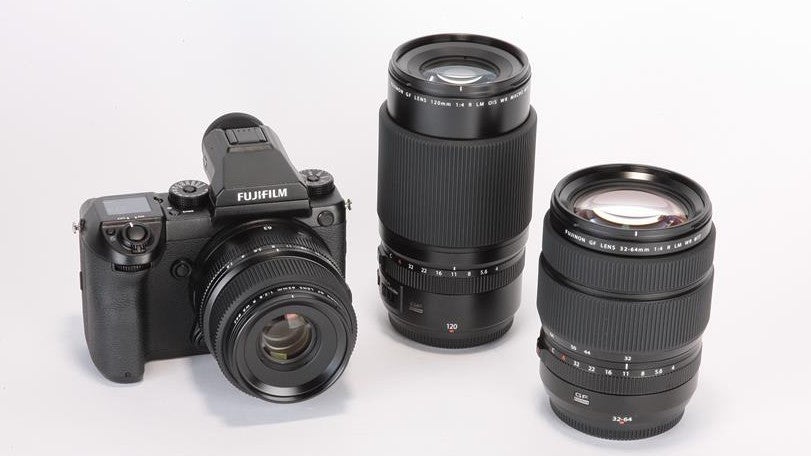
Sections
- Page 1 Fujifilm GFX 50S Review
- Page 2 Viewfinder, Screen and Performance Review
- Page 3 Image Quality and Verdict Review
Verdict
Pros
- Phenomenally good resolution and dynamic range
- Intuitive layout of buttons and controls
- More compact than you’d assume from medium format
- Removable viewfinder with optional tilt adapter
Cons
- Autofocus performance
- Touchscreen could be implemented further
- Out of its comfort zone when shooting action and sport
Key Specifications
- Review Price: £6199.00
- 51.4-megapixel medium-format sensor (8256 x 6192 max resolution)
- Fujifilm G-mount
- 100-12,800 (50-102,400 extended)
- 60min-1/4000sec (Mechanical Shutter), 60min-1/16,000sec (Electronic shutter)
- 117-point contrast-detect AF system
- 3fps continuous shooting
- Dual SD card slots
- Full HD video (30/25/24p)
- 3.2-inch, 2.36-million-dot LCD touchscreen
- 0.5-inch, 3.69-million-dot OLED viewfinder
- 145.5 x 94.2 x 91.4mm, 825g (with battery and memory card)
What is the Fujifilm GFX 50S?
The wait for Fujifilm’s eagerly anticipated medium-format mirrorless camera is over. This monster is aimed at professional and commercial shooters who insist on nothing but the finest image quality – and to that end it boasts a sensor 1.7x larger in area than a 35mm full-frame chip.
The GFX 50S sits alongside the Pentax 645Z and Hasselblad X1D-50c, adopting a similar approach to Fujifilm’s X-series models in the way it’s designed to be smaller, lighter and generally more convenient to use than its rivals.
This is one seriously impressive camera – although even at this heady price, there’s still a little room for improvement.
Related: Best Cameras to Buy 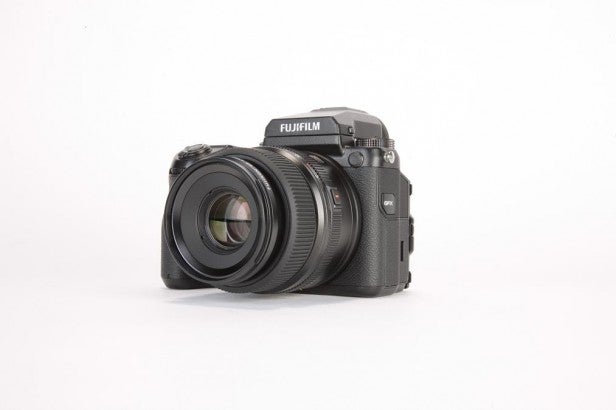
Fujifilm GFX 50S – Features
The GFX 50S represents the first model in what will be a range of GFX cameras, and is equipped with a 51.4-megapixel sensor boasting an effective 8256 × 6192-pixel resolution in the 4:3 aspect ratio.
This G-format sensor is four times the size of sensors found in Fujifilm’s APS-C X-series cameras. Who actually makes the chip isn’t clear, but I suspect it’s made by Sony and is the same model found in the Hasselblad X1D.
Although the pixel count here isn’t significantly higher than that in the Canon EOS 5DS or EOS 5DS R, the pixel pitch is greater, which should see the GFX 50S deliver a wide dynamic range and an impressive noise response at high sensitivities. On the subject of sensitivity, the camera provides a standard ISO range of 100-12,800, which is expandable to ISO 50-102,400.
Unlike some previous Fujifilm cameras, RAW format recording is supported at all ISO settings and the Auto function allows you to set the standard ISO, low shutter speed limit and upper ISO limit.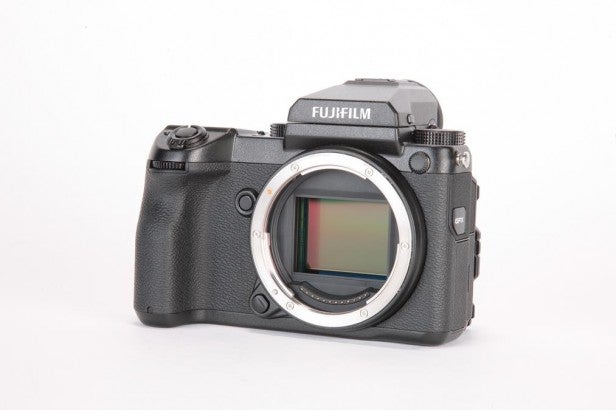
To ensure the form factor is kept as compact as possible, the camera features a mirrorless design with a focal-plane shutter that’s claimed to be good for 150,000 actuations. If you wish to shoot faster than the mechanical shutter’s 1/4000-second limit then you can employ the electronic shutter, which lets you dial in a shutter speed up to 1/16,000 of a second. In addition, there’s the option to select an electronic front curtain shutter.
As with the company’s X-Pro2 and X-T2 models, the GFX 50S features Fujifilm’s latest X Processor Pro imaging engine. The fact that it shoots at just 3fps in its continuous shooting mode highlights that this camera isn’t built for speed and is better suited to landscape, portrait and studio work, where rattling out a fast burst in short succession isn’t quite as critical.
With regard to focusing, the GFX 50S provides a spread of 117 contrast-detect AF points in a 9 x 13 formation across the frame. If this doesn’t seem enough and more accurate pinpoint control is required, there’s the option to swap to 425 contrast-detect points in a 17 x 25 arrangement.
Like the X-T2 and X-Pro2, a dedicated focus lever is put to use to highlight and reposition the focus point, but you can also tap the touchscreen to adjust focus if you’d prefer. 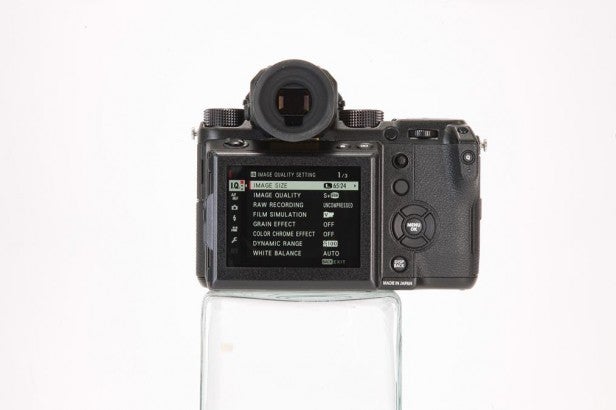
As a camera that’s out to appeal to high-end stills photographers, it’s no great surprise to discover that 4K video is missing. Those wishing to record the occasional movie will have to make do with Full HD recording at 30, 25 or 24fps (36Mbps) with a maximum recording time of 30 minutes.
On the left side of the body you’ll find a pair of 3.5mm ports to attach a microphone or plug in headphones for audio monitoring, while on the opposite side sit dual SD card slots behind a weather-sealed flap.
Other connections include USB 3.0 for computer-tethered shooting, an HDMI micro connector to output images to an external monitor, and a 2.5mm remote shutter-release terminal. You can connect the optional AC power adapter AC-15V to the DC input to use an external power source for camera operation and charging. A cable lock is also supplied to ensure cables attach safely and securely.
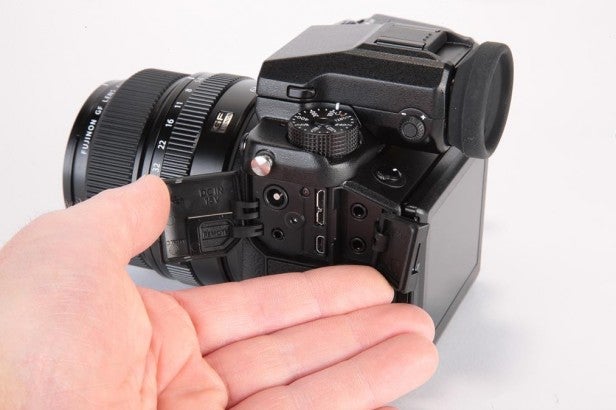
The GFX 50S pairs with mobile devices via Wi-Fi in the same way as the company’s X-series models. Wi-Fi can be assigned to any of the function buttons, and then from the camera’s wireless settings you can turn the ‘resize image for smartphone’ setting on to downsize images to a 3-megapixel resolution to save memory space.
The GFX 50S saves images in a variety of formats and quality, including two sizes and three compression levels of JPEG (Normal, Fine and Super Fine) as well as compressed/uncompressed RAW.
When you enter the main menu, the first option you’ll find under the image quality setting is Image Size. From here you have the opportunity to select your preferred aspect ratio. The default 4:3 (8256 x 6192) aspect ratio is found at the top, with 3:2 (8256 x 5504), 16:9 (8256 x 4640), 1:1 (6192 x 6192), 65:24 (8256 x 3048), 5:4 (7744 x 6192), and 7:6 (7232 x 6182) aspects listed beneath.
It’s rather helpful that the GFX 50S displays the pixel resolution for each aspect as well as the number of frames you’ll be able to shoot on the card that’s loaded at the bottom of the screen.
When you’re shooting, you can glance at the top-plate LCD to check what image quality the camera is set to. However, it’s worth bearing in mind that no icon is displayed on the top panel when the camera is set to shoot in the RAW format only.
Related: Fujifilm X-T2 review
Fujifilm GFX 50S – Design and Handling
Although the GFX 50S is an entirely different proposition to cameras in the X series, it bears some resemblance to Fujifilm’s smaller, mirrorless models. Those familiar with cameras such as the X-Pro2 and X-T2 will feel at home with the GFX 50S in their hands, since many of the buttons and dials operate similarly and are positioned in such a way that you don’t feel like you’re hunting around to find what you need.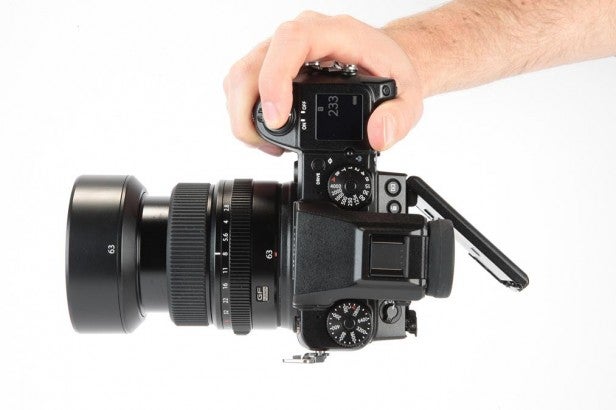
Wrap your palm around the camera’s chunky rubberised handgrip and your thumb rests comfortably beneath the rear dial and off to the side of the focus lever. The latter is great for nudging the AF point quickly, and also highlights the current position of your AF point with a single press – or, instantly repositions the point back to the centre with a double-press.
On the corner of the thumb rest you get a small button to gain access to the quick menu, which can be customised to display regularly used settings as you wish them to appear. Just above this is a small customisable function button – just one of nine buttons across the body that can be issued to one of 36 different settings.
It’s also possible to assign a new role to the rear dial when it’s depressed, but I found it best to keep it set to focus check, which is its default setting. 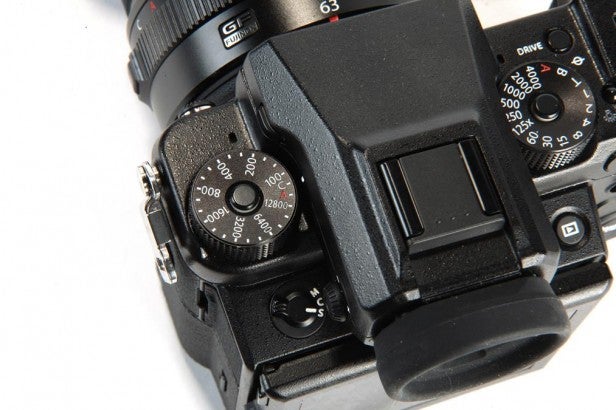
Up on the top plate there are two large dials to take manual control of shutter speed and ISO. Rotate the shutter speed dial to its ‘T’ setting and you can scroll through the full shutter speed range using the rear dial, with the option to set an exposure as slow as 60 minutes.
One great addition is Fujifilm’s decision to add a ‘C’ setting to the ISO dial between the Auto ISO and ISO 100 settings. This allows you to override the ISO dial and control the sensitivity using the front dial. To prevent the dial being knocked and the sensitivity being adjusted unexpectedly, Fujifilm has added a fail-safe function whereby the dial has to be depressed prior to adjusting the ISO.
Essentially, this allows you to take control of shutter speed, aperture (provided the lens is set to its ‘C’ setting) and ISO independently via your right hand, without touching the top plate dials or having to pull your left hand away from supporting a heavy lens.
Anyone struggling to find the video mode will discover it buried at the bottom of the drive mode settings, and although I found the button layout to be good in general, the position of the playback and delete buttons did prove to be rather awkward; they can’t be accessed with your right hand when you have a solid grasp of the camera. One workaround is to customise the Fn4 button to perform playback, which then allows you to access it with your thumb.
My only other issue is the shutter button, which isn’t threaded and annoyingly prevents the use of a screw-in-style cable release.
Although some may question the lack of an exposure compensation dial, it’s easy enough to hold the small dedicated button beside the on/off switch and dial in a few stops of compensation using the rear dial.
The GFX 50S feels solid, robust and more than up to the task of being used outside of a controlled studio environment. Its durable magnesium-alloy body comes with no fewer than 58 weather seals to prevent dust, sand or moisture from entering and damaging the internals.
The camera didn’t flinch at being caught up in a sand storm at the beach during testing, and didn’t show any side effects from becoming wet during an unexpected downpour on a landscape shoot.
The overall build quality is of such a high standard that I can’t think of any challenging environments – other than maybe the arctic or underwater – where the GFX 50S would be out of its comfort zone.
Just to add a little extra peace of mind, all GFX 50S users qualify for Fujifilm’s professional service scheme for two years, promising customers a free loan until a repaired camera is returned. You’re also eligible for free health checks and sensor cleans, discounts on repairs, and access to a dedicated support line.


